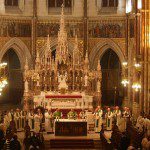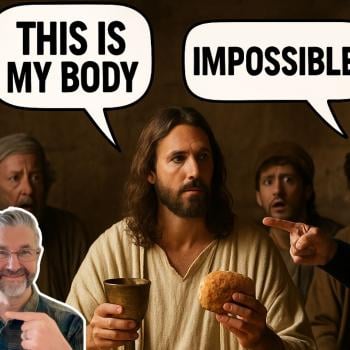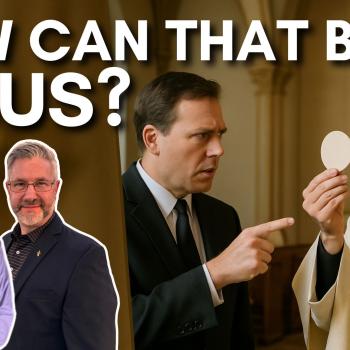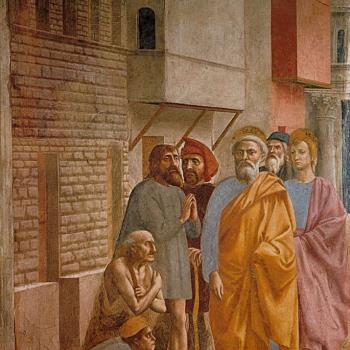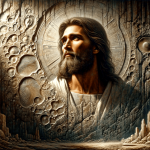. . . with Dr. Stanley Williams
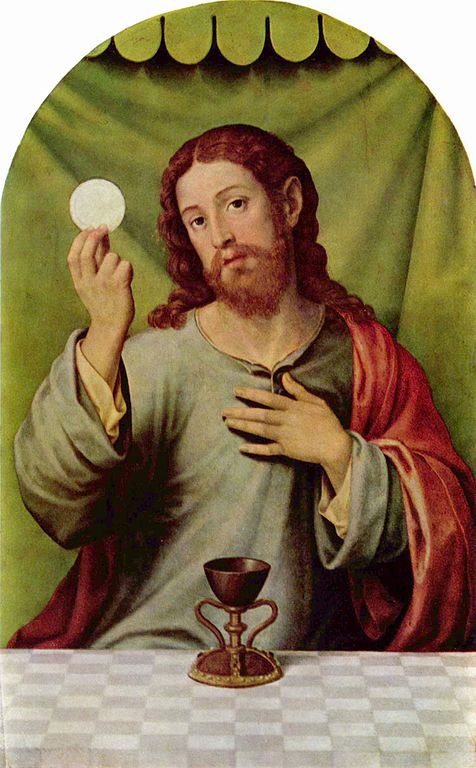
Christ with the Eucharist, late 16th century, by Joan de Joanes (1510-1579) [public domain / Wikimedia Commons]
***
(7-18-07)
****
This is an extended excerpt from my DVD Study Guide for the EWTN television series What Catholics Really Believe. The questions (in blue) were written by my friend, Dr. Stanley Williams.
* * * * *
Episode 4
EUCHARIST I
Logical and Early Church Evidence
Objection to Catholicism
A – Catholics cannot really believe that the bread and wine taken in communion are truly the body of Jesus Christ; our physical senses tell us that it’s flour and wine.
Physical objects that appear solid are mostly composed of what?
Space in between atoms, composed of protons, neutrons, and electrons.
Describe the motion of physical objects that appear to be still?
Electrons are always moving. The Austrian physicist Erwin Schrodinger, in the 1920s, contended (quite successfully) that electrons are three-dimensional waveforms, as opposed to particles.
How fast are parts of the atoms in a still object actually moving?
Electrons constantly move at velocities approaching the speed of light.
Do our physical senses give us an accurate or an inaccurate understanding of an object’s actual nature?
Physical senses (without the aid of sophisticated microscopes, accompanied by even more complicated theories of physics and mathematics) cannot enable us to comprehend the fundamental properties of matter.
How do Dr. Guarendi and Dr. Richard’s explanation of the laws of physics and our observations of a physical object apply to our understanding of the nature of The Eucharist?
What “appears” to be so may not be that way at all. Objects that appear perfectly at rest are in fact, partially moving at velocities close to the speed of light. Likewise, what appears to us as bread and wine can in fact be the Body and Blood of Christ, made supernaturally present in the consecrated elements (formerly bread and wine), according to the teaching of Jesus Christ Himself: the same Jesus Who could travel through walls in His glorified body (John 20:26; cf. 1 Cor 15:51-53). According to modern physics and quantum mechanics, such things are literally possible, even in a purely physical realm. So how is there any inherent difficulty in believing in transubstantiation (“change of substance”)?
If our physical senses are incapable of accurately describing a natural object, by what can we accurately describe a supernatural object?
The Bible describes supernatural objects with “phenomenological” language (the language of appearances and simple observation). For example, in the previous example of Jesus walking through walls, the Bible doesn’t attempt to delve into 20th century particle physics; it simply says “The doors were shut, but Jesus came and stood among them . . .” (John 20:26). Likewise, the Bible refers to “this [what appears to be bread] is My Body” (Luke 22:19-20), and Paul equates bread and wine with the “body and blood of the Lord” that can be profaned in an irreverent receiving of the Eucharist (1 Cor 11:27-30; cf. 10:14-22).
Objection to Catholicism
B – Jesus was not God because he did not look like God. He looked just like man.
If we could have looked through a microscope at the embryo of Jesus Christ in Mary’s womb, would our senses have perceived God or just a human cell reproducing? Why?
The attributes of the incarnate God cannot be ascertained by conventional methods of scientific observation. Jesus wanted people to accept Who He was by faith. Hence, Jesus says to “doubting Thomas” after the latter had put his hand in the wound in His side: “Have you believed because you have seen me? Blessed are those who have not seen and yet believe” (John 20:29).
When Jesus was a man did people generally see a man, or did they recognize God? Why?
Those who did not have doubt or serious sin and spiritual “blindness” (John 9:39-41) often regarded Him as God, in faith; for example, the blind man healed by Jesus, who worshiped Him (John 9:35-38), and “doubting Thomas,” after Jesus appeared to him (John 20:28). The ones who were blind assumed that He was not only just a man, but also a quite sinful one (John 9:24; cf. Matt 12:22-27, 38-42).
What prevents humans from recognizing God in any form, such as Jesus the Man, or Jesus in the Eucharist?
Lack of faith, and excessive doubt and cynicism. Signs, wonders, and miracles (and by extension, “scientific proof”) do not suffice for many hard-hearted people anyway:
. . . If they do not hear Moses and the prophets, neither will they be convinced if some one should rise from the dead. (Luke 16:31)
In John 6, we see that unbelief and lack of faith and skepticism kept “many of his disciples” (6:60) from believing in the Real Presence in the Eucharist, and actually forsaking the Lord (6:66), because it was a “hard saying” (6:60). Jesus appealed to His ascension, which was an even greater, and more visible miracle (6:62) thus seemingly implying: “if you can’t believe this miracle, how, then, will you be able to believe in that one; yet you will see that with your own eyes.”
If we cannot use our senses to determine if something is God or not, what can we use? Why?
Faith and the sure word of revelation; also our internal God-given sense of the holiness that Jesus exhibited in His life, and the trustworthy reports of those who were eyewitnesses of His glory (Luke 1:1-2; Acts 1:1-3). See the previous three answers.
What is wrong with using natural law to explain the “super” natural?
Nothing whatsoever! We can utilize that which we know and understand, in order to comprehend (by analogy or parallel) supernatural things that are mysteries to us. Jesus did the same, by using agricultural metaphors in His parables, to reveal the truths of spirituality. Our Lord even compared the unwillingness of the Pharisees and Sadducees to use the same reasoning they use with regard to natural meteorological events of the weather, and apply it to spiritual matters:
Matthew 16:1-4 And the Pharisees and Sad’ducees came, and to test him they asked him to show them a sign from heaven. He answered them, “When it is evening, you say, `It will be fair weather; for the sky is red.’ And in the morning, `It will be stormy today, for the sky is red and threatening.’ You know how to interpret the appearance of the sky, but you cannot interpret the signs of the times. An evil and adulterous generation seeks for a sign, but no sign shall be given to it except the sign of Jonah.” So he left them and departed.
Objection to Catholicism
C – The Eucharist is just a memorial or symbolic meal. That it is the real body and blood of Christ, is something made up by the Catholic Church over the centuries.
Explain how John 6 refutes this objection?
Jesus uses extremely literal language in John 6:51-58:
51: I am the living bread which came down from heaven; if any one eats of this bread, he will live for ever; and the bread which I shall give for the life of the world is my flesh.”
52: The Jews then disputed among themselves, saying, “How can this man give us his flesh to eat?”
53: So Jesus said to them, “Truly, truly, I say to you, unless you eat the flesh of the Son of man and drink his blood, you have no life in you;
54: he who eats my flesh and drinks my blood has eternal life, and I will raise him up at the last day.
55: For my flesh is food indeed, and my blood is drink indeed.
56: He who eats my flesh and drinks my blood abides in me, and I in him.
57: As the living Father sent me, and I live because of the Father, so he who eats me will live because of me.
58: This is the bread which came down from heaven, not such as the fathers ate and died; he who eats this bread will live for ever.”
If this were intended as mere symbolic or figurative language, it seems that it was the least likely to convey that meaning, of any language imaginable. How could it be any more literal than it is? How Jesus reacted to the doubts of the hearers (see related information above), also reinforces this interpretation.
How do the writings of the Early Church Fathers refute this objection?
In the early second century (before 110 A.D.), St. Ignatius of Antioch held that “the Eucharist is the Flesh of our Savior Jesus Christ.” (Letter to the Smyrnaeans, 7,1) In the middle of the same century, St. Justin Martyr distinguishes the Eucharist from “common” bread and drink and calls it “both the flesh and the blood of that incarnated Jesus.” (First Apology, 66,2) A little later, St. Irenaeus writes, “The bread over which thanks have been given is the Body of (the) Lord, and the cup His Blood.” (Against Heresies, 4,18,4 / 4,33,2; cf. 4,18,5).
St. John Chrysostom speaks of the priest as the representative of God in the Mass, exercising solely His power and grace, in order to “transform the gifts” which “become the Body and Blood of Christ.” (Homilies on Judas, 1,6) Elsewhere he equates the Eucharist with Christ’s “blood-stained” Body, “pierced by a lance.” (Homilies on 1 Corinthians, 24).
St. Augustine, the greatest of the Fathers, writes that “Christ was carried in His own hands, when, referring to His own Body, He said ‘This is My Body.'” (Explanations of the Psalms, 33,1,10) He expressly sanctions adoration of the consecrated Host:
He took flesh from the flesh of Mary . . . and gave us the same flesh to be eaten unto salvation. But no one eats that flesh unless first he adores it . . . we do sin by not adoring. (Explanations of the Psalms, 98,9)
When Christ says “I will be with you always, even until the end of the world,” why do Catholics believe this promise to be the literal physical
presence of Jesus and not the Holy Spirit?
Because right before He said this (Matt 28:20) He also urged His disciples to “observe all that I have commanded you”. The Eucharist was precisely what Christians do (in obedience to the command at the Last Supper) to bring remembrance to Jesus’ presence on earth; and not only remembrance, but Real Presence. Paul said that in observing the Eucharist, we “proclaim the Lord’s death until he comes” (1 Cor 11:26). John 6:53-54,58 intimately connects the Eucharist with both spiritual and eternal life. John 6:56 makes reception of the Eucharist a necessity for Jesus to “abide” in believers, and vice versa (cf. John 14:23, 15:4-7).
One of the objections against the early Christians was that during their worship services they were practicing cannibalism. How does this historical
fact reinforce the Early Church belief in the true presence?
It shows that the early Christians were taking Jesus literally (John 6; Last Supper utterances about the bread and the wine being His Body and Blood). But the pagans (like the skeptics who disbelieved in John 6) did not understand the distinction between physical cannibalism and a spiritual, sacramental Real Presence.
Explain how John 1:1 (“In the beginning was the Word…”) and John 1:14 (“And The Word was made flesh, and dwelt among us…”) reflects the
Catholic Mass and the Real Presence of Christ in the Eucharist.
This involves the intimate connection between the incarnation and the Eucharist (both entail physical presence of God Himself). Catholic convert Thomas Howard elaborates:
Sacrament, recalling and presenting the Incarnation itself, is not so much supernatural as quintessentially natural, because it restores to nature its true function of being full of God . . . Indeed heaven and earth are full of His glory. Nature is the God-bearer, so to speak . . . In the Sacrament, bread, which is already a metaphor, is taken and raised to a dignity beyond mere metaphor . . . one step away from the Incarnation itself . . . It is a scandal. God is not man, any more than bread is flesh. But faith overrides the implacable prudence of logic and chemistry . . .
This mystery . . . may be held only in faith, even though it, like the Incarnation, Resurrection, and Ascension, exists quite apart from faith. `out there’ in the real world. (Evangelical is Not Enough, Nashville: Nelson, 1984, 110-112)
Objection to Catholicism
D – Catholics just pick and choose the writings of the Early Church Fathers in an attempt to prove that the early Christians believed in the Real Presence of Christ in the Eucharist. There were other writers who said it was only symbolic.
What is the best way to refute this objection?
By citing the judgment of Protestant Church historians, who themselves do not believe the Catholic doctrine on the Eucharist (hence cannot be accused of bias in favor of patristic support for the doctrine), yet accurately report what the Fathers believed. For example, the well known Protestant historian Philip Schaff:
The doctrine of the sacrament of the Eucharist was not a subject of theological controversy . . . . till the time of Paschasius Radbert, in the ninth century . . .
In general, this period, . . . was already very strongly inclined toward the doctrine of transubstantiation, and toward the Greek and Roman sacrifice of the mass, which are inseparable in so far as a real sacrifice requires the real presence of the victim……
[Augustine] at the same time holds fast the real presence of Christ in the Supper . . . He was also inclined, with the Oriental fathers, to ascribe a saving virtue to the consecrated elements.
Augustine . . . on the other hand, he calls the celebration of the communion ‘verissimum sacrificium’ of the body of Christ. The church, he says, offers (‘immolat’) to God the sacrifice of thanks in the body of Christ. [City of God, 10,20]
(History of the Christian Church, v.3, A.D. 311-600, rev. 5th ed., Grand Rapids, Michigan: Eerdmans, rep. 1974, orig. 1910, 492, 500, 507)
What did Luther say about the true presence of the Eucharist?
It is enough for me that Christ’s blood is present; let it be with the wine as God wills. Before I would drink mere wine with the Enthusiasts, I would rather have pure blood with the Pope. (Early 1520s; in Paul Althaus, The Theology of Martin Luther, translated by Robert C. Schultz, Philadelphia: Fortress Press, 1966, 376; Luther’s Works, [edited by Jaroslav Pelikan] 37, 317)
The glory of our God is precisely that for our sakes he comes down to the very depths, into human flesh, into the bread, into our mouth, our heart, our body. (in Althaus, ibid., 398; Luther’s Works , 37, 71 ff.)
. . . Zwingli, Karlstadt, Oecolampadius . . . called him a baked God, a God made of bread, a God made of wine, a roasted God, etc. They called us cannibals, blood-drinkers, man-eaters . . . even the papists have never taught such things, as they clearly know . . .
For this is . . . how it was accepted in the true, ancient Christian church of fifteen hundred years ago . . . When you receive the bread from the altar, . . . you are receiving the entire body of the Lord; . . . (Brief Confession Concerning the Holy Sacrament, September 1544; Luther’s Works, 38, 291-292)
What symbol in the catacombs and ancient churches reinforced the early Church’s belief in the true presence of Christ in the Eucharist?
The famous symbol of the fish, and depictions of three of Jesus’ miracles related to food: the feeding of the 5,000 with fish and bread, the banquet of seven disciples by the Sea of Galilee with the raised Jesus, and the miracle of the wedding at Cana (changing water into wine).
Episode 5
EUCHARIST II
Scriptural Evidence
REVIEW of EPISODE 4 – EUCHARIST I
Objection to Catholicism
A – The Catholic Church invented this crazy idea that Jesus’ body and blood are really present in the Eucharist. It’s really nuts to think that a priest can pray over a wafer and turn it miraculously into Jesus Christ.
If the Catholic claim that Jesus is truly present in the Eucharist is true, who is the only person that could be responsible for the miracle of it?
Jesus Himself! If that is how He decided to miraculously become physically present again, after His earthly sojourn, then we can hardly object, seeing that it is hardly any different in essence than the Incarnation itself: God becoming man. On the other hand, if it is false doctrine, no priest could “conjure” up Jesus’ presence, because they are dealing with the omnipotent God, and He is not to be trifled with or manipulated.
How early in the writings of the Early Church Fathers, and in what context, can you find the concept of transubstantiation?
St. Justin Martyr, First Apology, 66:5 (complete; emphasis added):
And this food is called among us [eucharistia] [the Eucharist], of which no one is allowed to partake but the man who believes that the things which we teach are true, and who has been washed with the washing that is for the remission of sins, and unto regeneration, and who is so living as Christ has enjoined. For not as common bread and common drink do we receive these; but in like manner as Jesus Christ our Saviour, having been made flesh by the Word of God, had both flesh and blood for our salvation, so likewise have we been taught that the food which is blessed by the prayer of His word, and from which our blood and flesh by transmutation are nourished, is the flesh and blood of that Jesus who was made flesh. For the apostles, in the memoirs composed by them, which are called Gospels, have thus delivered unto us what was enjoined upon them; that Jesus took bread, and when He had given thanks, said, “This do ye in remembrance of Me, this is My body;” and that, after the same manner, having taken the cup and given thanks, He said, “This is My blood;” and gave it to them alone. Which the wicked devils have imitated in the mysteries of Mithras, commanding the same thing to be done. For, that bread and a cup of water are placed with certain incantations in the mystic rites of one who is being initiated, you either know or can learn.
Objection to Catholicism
B – The concept of the true presence of Christ in the Eucharist is not in the Bible.
With respect to the consecration of the Eucharist, what is the significance of the Bible’s mentioning Melchizedek?
Psalm 110:4: The LORD has sworn and will not change his mind, “You are a priest for ever after the order of Melchiz’edek.”
When we trace the origin of this back, we find some very interesting things:
Genesis 14:18: And Mel-chiz’edek king of Salem brought out bread and wine; he was priest of God Most High.
Leviticus 23:12-14: And on the day when you wave the sheaf, you shall offer a male lamb a year old without blemish as a burnt offering to the LORD. And the cereal offering with it shall be two tenths of an ephah of fine flour mixed with oil, to be offered by fire to the LORD, a pleasing odor; and the drink offering with it shall be of wine, a fourth of a hin. And you shall eat neither bread nor grain parched or fresh until this same day, until you have brought the offering of your God: it is a statute for ever throughout your generations in all your dwellings. (cf. also Hebrews 5:6,10; 6:20; 7:1-28)
What was the function of the Old Testament priest?
The priest presided over and performed ritual sacrifices of bulls and other things, in order to atone for the sins of the people.
How did Christ’s actions and words at the Last Supper parallel the Old Testament priestly sacrifice for people’s sins?
The Last Supper was actually a Passover meal, in which lamb and bread and wine were consumed, and was for the purpose of the people remembering how God had physically delivered them from bondage in Egypt. Jesus used this symbolism to introduce the notion of the Eucharist: now bread and wine were to be transubstantiated into His Body and Blood and His followers would be spiritually delivered by His sacrifice as the “lamb of God, who takes away the sin of the world” (John 1:29). And they were to remember this in the Eucharist henceforth, just as the Jews observed the Passover rite in remembrance.
Although Christ lifts up the bread at the Last Supper what does he say the bread is? (Matthew 26:26, Mark 14:22-23, Luke 22:19-20, 1 Corinthians 11:23-25)
“This is My body” – as opposed to “this represents My body” or “this contains my Body” or “My Body is present with, in, and under the bread”, or “this is a symbol to help you remember My Body,” etc.
When Christ prays over the bread and wine at the last supper, what words does he use that can be implied to mean that the bread and wine are only
symbolic of his body and blood?
None can be reasonably interpreted that way. The closest (so some believe) is “do this in remembrance of me.” But in the Hebrew mind that didn‘t imply that it was a mere recollection or mental image or pleasing nostalgia; but rather, the reality being made present here and now, just as the Jews regarded Passover.
What did St. Augustine say Jesus held in his hands at the Last Supper?
His own Body: “Christ was carried in His own hands, when, referring to His own Body, He said ‘This is My Body.'” (Explanations of the Psalms, 33,1,10)
At the Last Supper to what everlasting Old Testament concept did Jesus relate the cup of wine?
The covenant between God and His people:
Matthew 26:28: for this is my blood of the covenant, which is poured out for many for the forgiveness of sins.
Mark 14: 24: And he said to them, “This is my blood of the covenant, which is poured out for many.”
What Old Testament object of sacrifice did the blood of Christ represent?
Bulls, rams, and lambs, used in ritual sacrifice, for atonement. Revelation 7:14 and 12:11 refer to “the blood of the Lamb [Jesus].”
Jesus’ words and actions at the Last Supper revisited the Jewish Passover meal. What did those that celebrated the Passover meal have to eat —
completely?
The lamb, and bread and wine.
Explain the significance of the following Scripture in terms of the real presence of Christ in the Eucharist and the Jewish community?
My name will be great among the gentiles, from the rising to the setting of the sun. In every place, incense and pure offerings will be brought to my name. (Malachi 1:11)
In the New Covenant, the Lamb of God and the cross represent the continuation and development of the Old Testament sacrificial system (which is no longer even being performed by the Jews). This passage refers to the Gentiles “in every place” making pure offerings. But since it is not animal sacrifices, it is reasonable to assume that what is referred to is the sacrifice of the Mass and re-presentation of the sacrifice of Jesus, who as once for all, offered at Calvary. The incense represents the prayers of the Mass.
In John 6:52-66, how many times does Jesus say or allude to His body or blood as being true food?
Twice very directly (6:55) and eight more times speaking of “eating “and “drinking”.
Fr. Kevin makes the point that John 6:66 is the only place in the Gospels where a group of believers walked away from Jesus and did not follow Him
again. What was Jesus teaching that was too hard for them to believe?
That His followers had to eat His flesh and drink His blood (sacramentally) in order to have spiritual and eternal life.
In terms of what Matthew, Mark, and Luke wrote about the bread and wine being the body and blood of Christ (Matthew 26:26, Mark 14:22-23, Luke 22:19-20) what is significant about when John wrote his Gospel and why?
By the time of John’s writing (later in the first century), the Gnostic heresy was starting to deny that Jesus had come in the flesh, and indeed, asserted that flesh itself was a bad thing. So John emphasized the physical and “realist” nature of the Eucharist over against that false teaching.
Non-Catholics might quote John 6:63 as evidence that Christ was speaking symbolically and not literally about the bread and wine being his true body and blood. Why is this not likely a good interpretation, and how does this verse reinforce Catholic understanding of the Eucharist’s reality?
Jesus was contrasting “flesh” in the sense of “flesh and blood” (or a merely natural human understanding; see, e.g., Matt 16:17 for a clear example of this meaning) to spiritual discernment. He wasn’t referring to the Eucharist, but rather to “the words that I have spoken”. “Spirit and life” refers back to His references to spiritual and eternal life as a result of partaking of the Eucharist (6:50-51,53-54,56-58).
In the Eucharistic consecration what does the “EPIKLESIS” prayer do, and why is it significant in relation to John 6:63?
It reinforces the power of Jesus’ words. God’s words bring about what they refer to. So when the priest repeats the words of Jesus at the Last Supper (the consecration), they continue to achieve what they did then, and Jesus becomes present through the power of the Word. Hence the relation to John 6:63: “the words that I have spoken to you are spirit and life.”
In Luke 22:19 Christ says during the Last Supper, “Do this in remembrance of me.” Non-Catholics believe that the word “remembrance” here means to remember symbolically. But what does “remembrance”, or “ANAMNESIS” in Greek, really mean? Why does this mean the opposite of “symbolic?”
It means “active re-presentation” according to Greek scholars. It is the opposite of symbolic just as “re-present” (the original thing again) is different from “represent” (one thing symbolizing another). Hence, Paul uses ultra-realistic language, even stating in 1 Cor 11:27 that partaking of the Eucharist unworthily is the same as profaning His Body and Blood.
Some non-Catholics interpret 1 Corinthians 11:27-30 — which includes Paul’s admonition about not discerning the body of Christ — as referencing the body of believers and not the real flesh of Christ. Why does Fr. Kevin say this makes no sense?
Because the language is related to the Eucharist instituted at the Last Supper. Jesus referred to the bread and the wine as His Body and Blood. The “Body of Christ” (the Church) is a completely different sense. So Paul equates the bread and the cup with the Body and Blood of Jesus in 1 Corinthians 11:27. In the next verse, he urges Christians to do a self-examination before receiving Holy Communion.
In Luke 24 Jesus appears to Cleopas and another disciple on the road to Emmaus. During their walk Jesus explains the Old Testament prophecies
about the Messiah. But the disciples do not recognize Jesus until when? What does Jesus do that suddenly opens their eyes with understanding?
When Jesus broke bread (a gesture reminiscent of the Last Supper): “When he was at table with them, he took the bread and blessed, and broke it, and gave it to them. And their eyes were opened and they recognized him; and he vanished out of their sight.” (Luke 24:30-31)
Explain how John 1:1, 14, 18 and Luke 24:30-31 can be related and apply to the true presence of Christ in the Eucharist.
It is when “the Word became flesh” that God was most fully revealed (John 1:18). As the Incarnation revealed God visibly, so the Eucharist makes Jesus present again and gives us spiritual life, through the same principle of the Incarnation and matter conveying grace. In this instance, the eyes of the two disciples were blinded until the moment of the Eucharist, and “then they recognized him”. The knowledge is spiritually discerned, but made possible through the instrument of the grace-infused (John 1:14) matter (in the Eucharist, the actual Body and Blood of Jesus).
*****
Meta Description: The usual objections to the Real Presence and transubstantiation are answered.
Meta Keywords: consecration, Holy communion, Holy Eucharist, Real presence, sacramentalism, sacrifice of the mass, substantial presence, The Mass, transubstantiation



